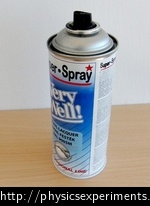Spray Cooling Effect
Experiment number : 4351
Goal of experiment
In this experiment we will demonstrate the rapid temperature drop caused by the intense evaporation of a liquid dispersed by an aerosol nebulizer (spray).
Theory
Sprays (or aerosol nebulizers) are used for dispensing liquid substances in the form of small particles dispersed in a gas – so-called aerosol. When a liquid is sprayed in the form of aerosol, i.e. in the form of very small droplets, the surface area and thus the evaporation rate increase dramatically for a given volume. As the volatile liquids used in the spray as propellants are usually part of the aerosol (see section “How sprays work”), evaporation is very intense. The liquid removes the specific heat of vaporization from its surroundings, causing a rapid temperature drop.
There are sprays used for cooling (filled with e.g. tetrafluoroethane or dimethyl ether, volatile liquids with a low boiling point) that reduce the temperature of the surface after application to the surface to below −50 °C (according to manufacturers).
Equipment
Thermal imaging camera, spray (deodorant, insecticide, spray colours, sprays for removing dust etc.), thermal insulating pad for spray application (wood, plastic, etc.).
In the sample experiment, a spray bottle designed to apply black fast-drying acrylic paint to wood, metal and plastic surfaces was used (Figure 1). A white painted chipboard was used as a pad.
Procedure
We apply the spray to a surface with low thermal conductivity and observe the temperature changes that occur due to evaporation of the sprayed liquid. As these are relatively rapid processes, where momentary inattention can be crucial, it is advisable to repeat the spray application several times in succession.
Sample result
A successful execution of the experiment is illustrated in the video below.
In this video, the FLIR i7 thermal imaging camera was used. The temperature range of the colour scheme was set in the interval of −9 °C and 34 °C, the emissivity was ε = 0.95.
Technical notes
Choose the spray carefully! Using deodorant or insecticide shouldn’t be a problem; however, inhaling aerosols of some industrial sprays can be irritating for more sensitive students. It is therefore advisable not to use them in closed and poorly ventilated rooms! Outside you can experiment without restrictions.
Do not apply the spray to materials that the liquid can pass through! There is a risk that the surface below can be damaged. For example, paper or fabric is unsuitable.
Pedagogical notes
If the students themselves carry out the experiment, it is essential to keep them under supervision. If they try to test the cooling effects of the spray on themselves and use a large amount of it, they are in real danger of frostbite. Even ordinary repellants and deodorants are able to reduce the temperature of the surface with room temperature in the order of tens of degrees Celsius!
The students can be motivated by their own experience. Probably, at least some of them have encountered the fact that when they use a deodorant or repellent during a hot summer day (with the spray being at thermal equilibrium with the surroundings), its application is still accompanied with a feeling of cold.
If we use a material with good thermal conductivity, the entire surface will be cooled down, not just the area affected by the aerosol. This fact can be presented to the students as an extension of the original experiment focusing on the visualization of the different thermal conductivity of substances.
How sprays work
The liquid is in the spray container together with the liquefied propellant; this mixture is maintained at a higher pressure than atmospheric pressure. It is essential that the propellant gas is a substance with a lower boiling point than the temperature at which the spray will be used – depending on the type of spray, propane-butane, dimethyl ether, tetrafluoroethane, isobutane, etc. are used – all having a boiling point below −10 °C. The higher pressure in the container prevents them from boiling immediately.
Pressing the spray button opens the valve, which pushes the liquid into the nozzle, spraying it into tiny droplets. This will drop the pressure in the container and cause the propellant to evaporate until the original pressure is restored – the spray is ready for use again.
Another experiments with sprays
The principle of aerosol sprays operation is clearly and vividly described in the contribution of associate professor Josef Hubeňák Technical Sprays in Physics Education, which was presented in 2010 at the Physics Teachers’ Inventions Fair 15 in Prague. This post also contains further inspiration for the wider use of sprays in physics teaching.
Thermal imaging camera basics – link to PDF
In this experiment, a thermographic measurement is used. The theory of thermography and basic recommendation and procedures that can help you obtain more accurate and undistorted results can be found in Experiments with thermal imaging camera (in Czech only).









